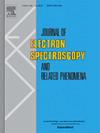Experimental study on low-pressure and high-temperature pyrolysis of 1, 3-butadiene using synchrotron radiation and SiC flash microreactor
IF 1.5
4区 物理与天体物理
Q2 SPECTROSCOPY
Journal of Electron Spectroscopy and Related Phenomena
Pub Date : 2025-03-04
DOI:10.1016/j.elspec.2025.147527
引用次数: 0
Abstract
1,3-Butadiene is a crucial intermediate in hydrocarbon combustion and pyrolysis processes and plays a significant role as a precursor in the formation of polycyclic aromatic hydrocarbons (PAHs) and soot. This study investigates the low-pressure and high-temperature pyrolysis of 1,3-butadiene by using a newly designed silicon carbide (SiC) tubular flow microreactor, in combination with supersonic molecular beam sampling, synchrotron radiation vacuum ultraviolet single-photon ionization, and reflective time-of-flight mass spectrometry (SR-VUV-TOF-PIMS). We identified 36 pyrolysis products, ranging in mass-to-charge ratio (m/z) from 15 to 128, which included free radicals and isomeric species. The study determined the initial pyrolysis temperature of the parent compound and the initial formation temperatures of the products. Comparative analysis of our results with previous literature revealed the primary cleavage pathways in this work: 1,3-C4H6 → C2H4 + C2H2, 1,3-C4H6 → 1,2-C4H6, 1,2-C4H6 → C3H3· + CH3·, 1,3-C4H6 + C3H3· → C3H4 + C4H5·, 1,3-i-C4H5· → C4H4 + H· and 1,3-n-C4H5· → C4H4 + H·. These studies contribute valuable insights into the mechanisms of hydrocarbon combustion and pyrolysis, as well as the reference for the formation processes of PAHs and soot.
同步辐射与SiC闪蒸微反应器低压高温热解1,3 -丁二烯的实验研究
1,3-丁二烯是碳氢化合物燃烧和热解过程中重要的中间体,在多环芳烃(PAHs)和煤烟的形成中起着重要的前体作用。采用新型碳化硅管流式微反应器,结合超声速分子束采样、同步辐射真空紫外单光子电离和反射飞行时间质谱(SR-VUV-TOF-PIMS)对1,3-丁二烯的低压高温热解进行了研究。我们鉴定了36种热解产物,其质量电荷比(m/z)从15到128不等,其中包括自由基和同分异构体。研究确定了母体化合物的初始热解温度和产物的初始形成温度。通过与已有文献的对比分析,揭示了本研究的主要裂解途径:1,3- c4h6→C2H4 + C2H2、1,3- c4h6→1,2- c4h6→C3H3·+ CH3·、1,3- c4h6 + C3H3·→C3H4 + C4H5·、1,3-i-C4H5·→C4H4 + H·和1,3-n-C4H5·→C4H4 + H·。这些研究有助于深入了解烃的燃烧和热解机理,并为多环芳烃和煤烟的形成过程提供参考。
本文章由计算机程序翻译,如有差异,请以英文原文为准。
求助全文
约1分钟内获得全文
求助全文
来源期刊
CiteScore
3.30
自引率
5.30%
发文量
64
审稿时长
60 days
期刊介绍:
The Journal of Electron Spectroscopy and Related Phenomena publishes experimental, theoretical and applied work in the field of electron spectroscopy and electronic structure, involving techniques which use high energy photons (>10 eV) or electrons as probes or detected particles in the investigation.

 求助内容:
求助内容: 应助结果提醒方式:
应助结果提醒方式:


